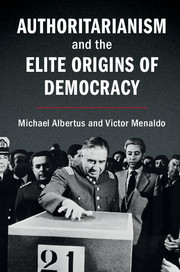Book contents
- Authoritarianism and the Elite Origins of Democracy
- Authoritarianism and the Elite Origins of Democracy
- Copyright page
- Contents
- Figures
- Tables
- Acknowledgments
- 1 Introduction
- 2 Elites and the Causes and Consequences of Democracy
- 3 Constitutions as Elite Deal Making
- 4 Evidence on the Causes and Consequences of Democracy
- 5 Unraveling the Deal
- 6 Sweden
- 7 Chile
- 8 Colonial and Occupier Legacies in New Democracies
- 9 Conclusion
- References
- Index
- References
References
Published online by Cambridge University Press: 21 December 2017
- Authoritarianism and the Elite Origins of Democracy
- Authoritarianism and the Elite Origins of Democracy
- Copyright page
- Contents
- Figures
- Tables
- Acknowledgments
- 1 Introduction
- 2 Elites and the Causes and Consequences of Democracy
- 3 Constitutions as Elite Deal Making
- 4 Evidence on the Causes and Consequences of Democracy
- 5 Unraveling the Deal
- 6 Sweden
- 7 Chile
- 8 Colonial and Occupier Legacies in New Democracies
- 9 Conclusion
- References
- Index
- References
- Type
- Chapter
- Information
- Authoritarianism and the Elite Origins of Democracy , pp. 289 - 302Publisher: Cambridge University PressPrint publication year: 2018



